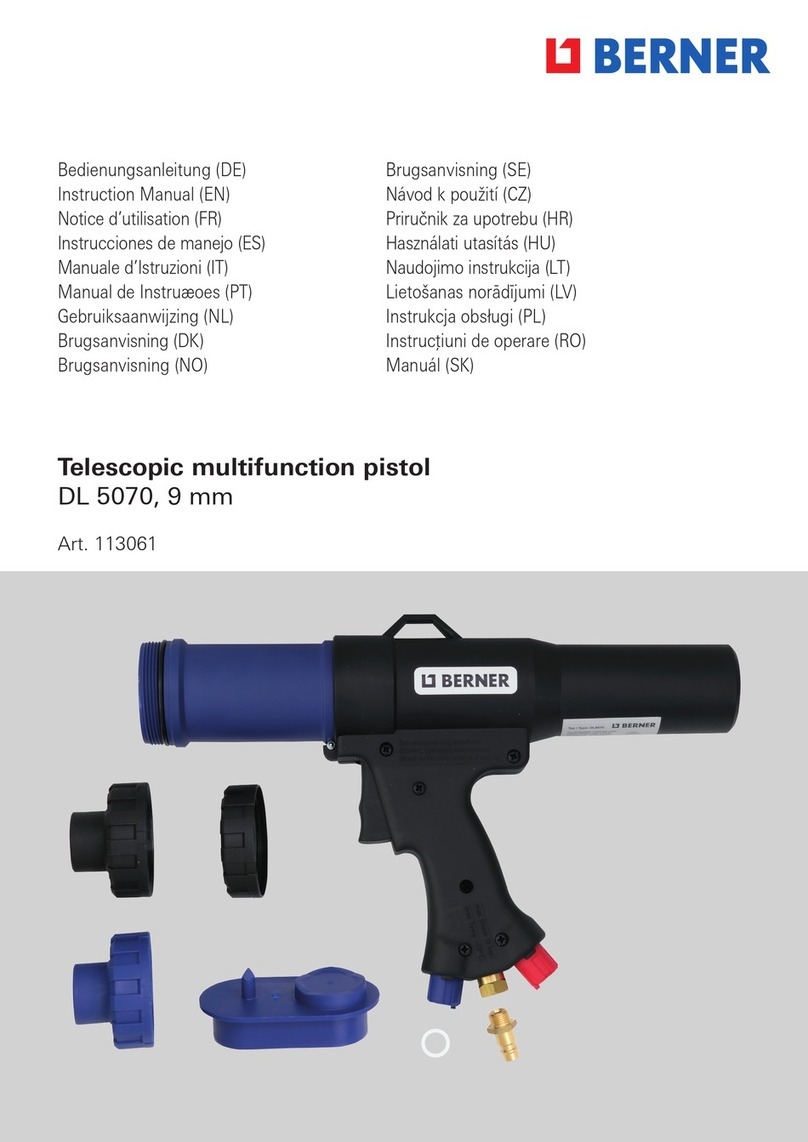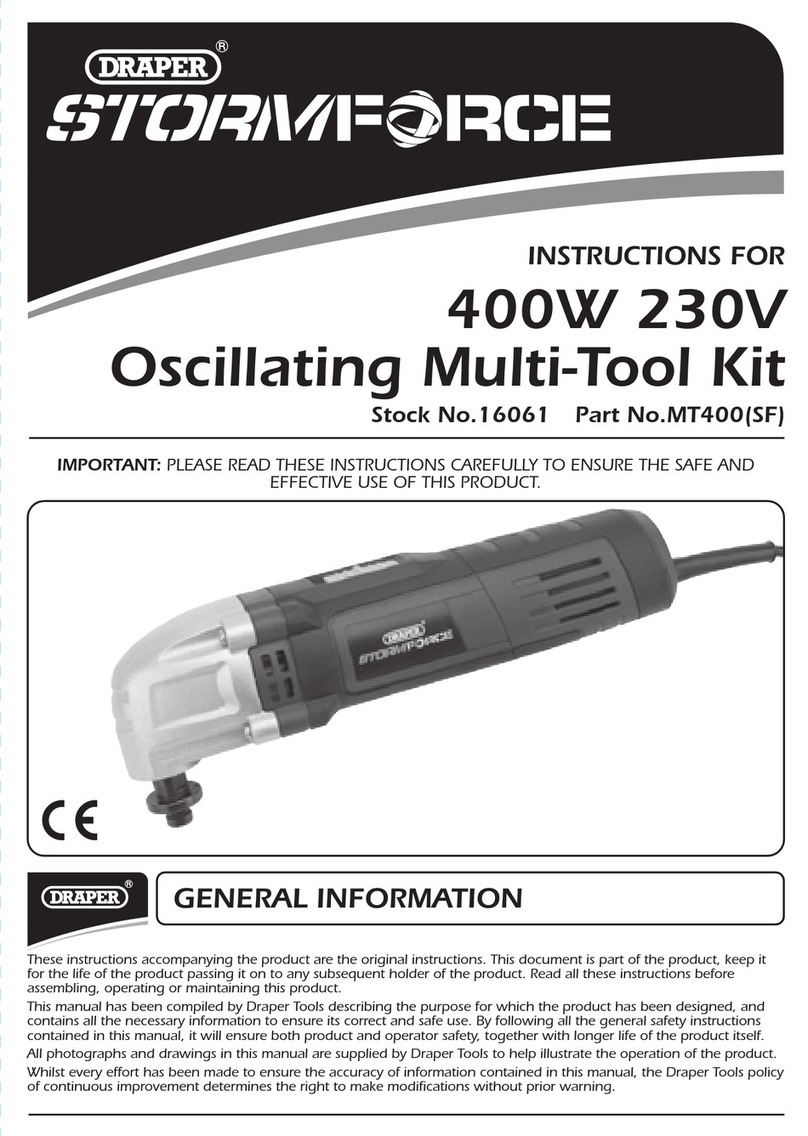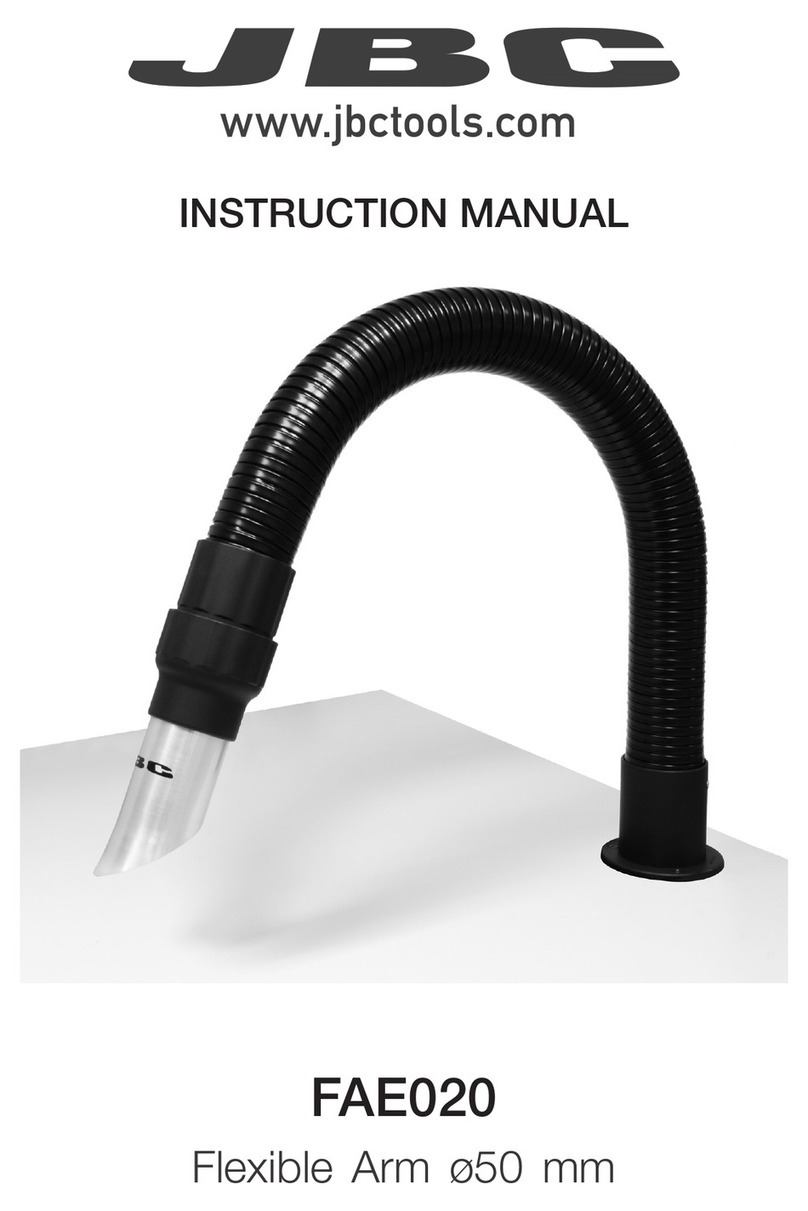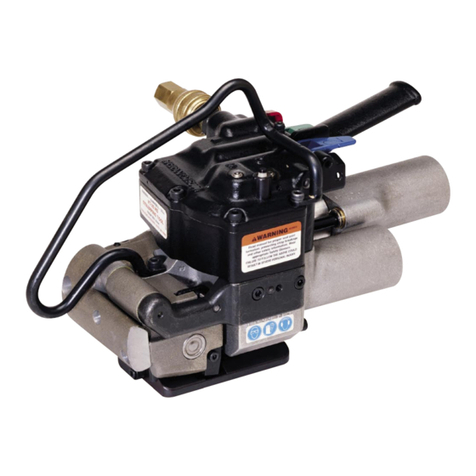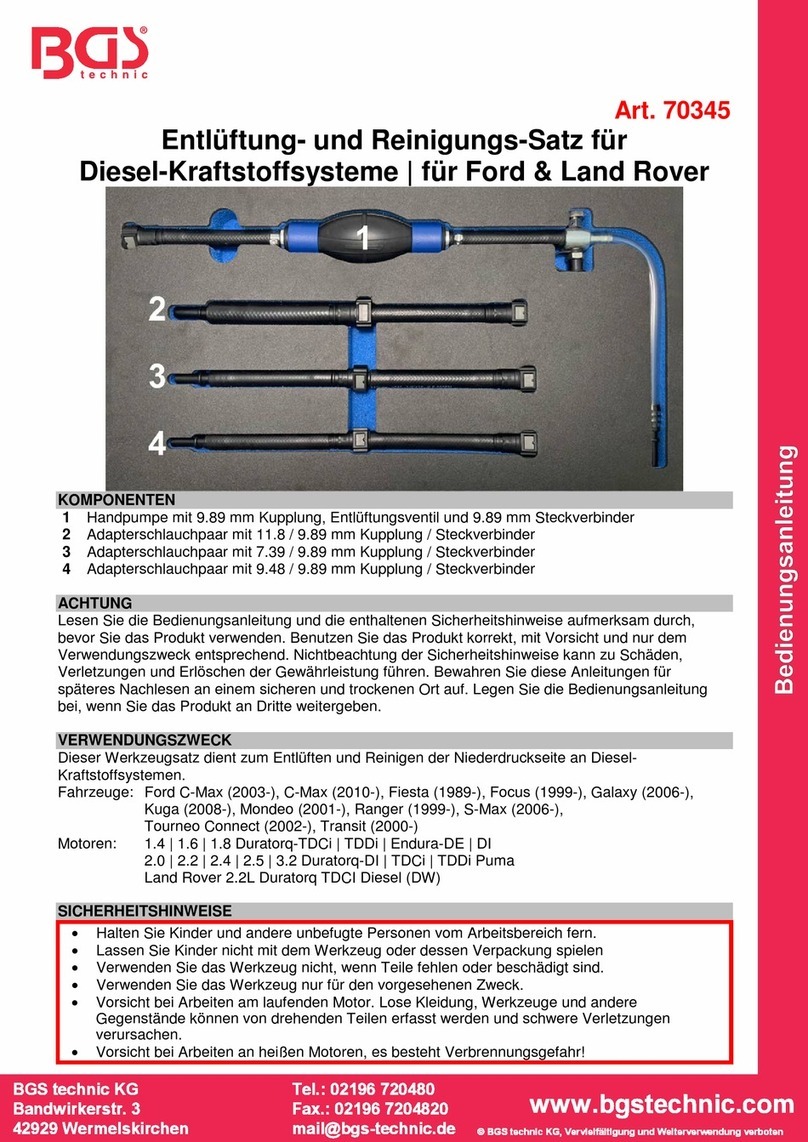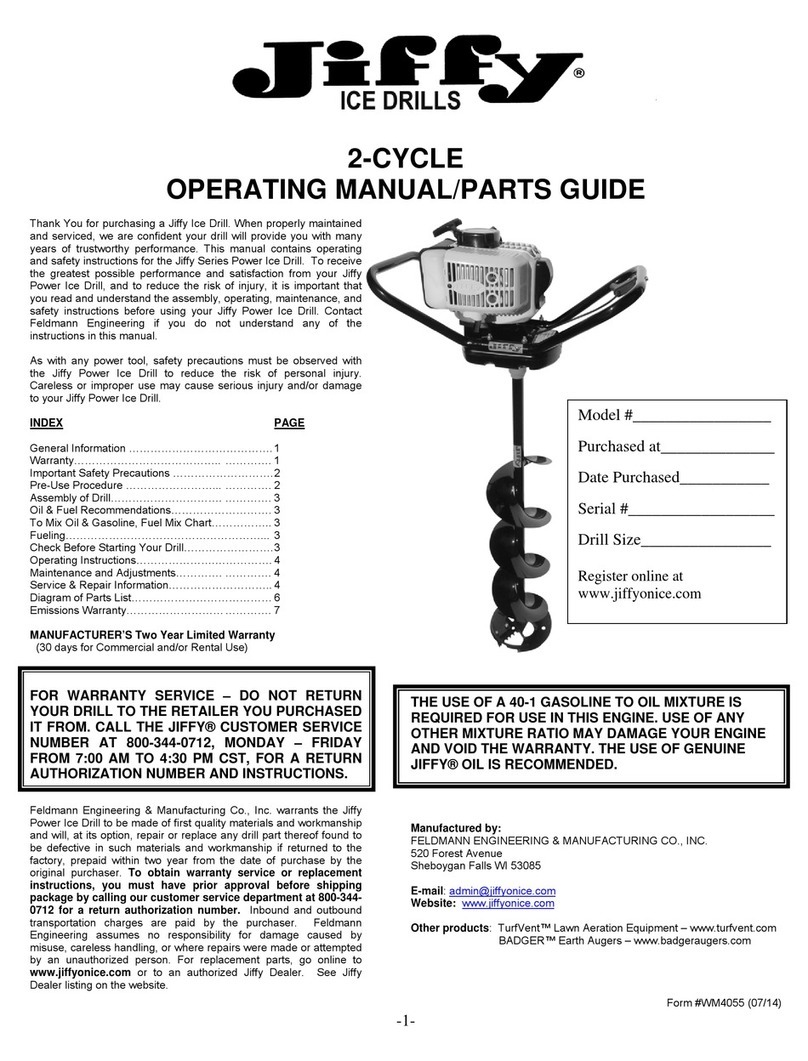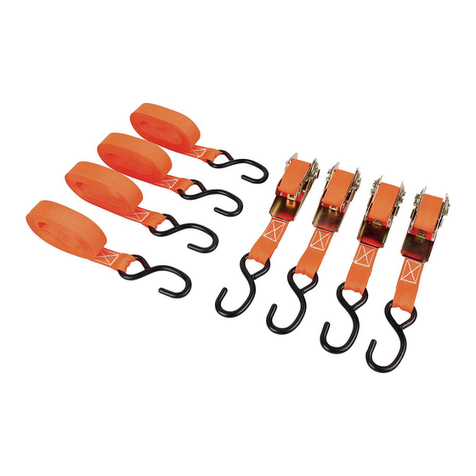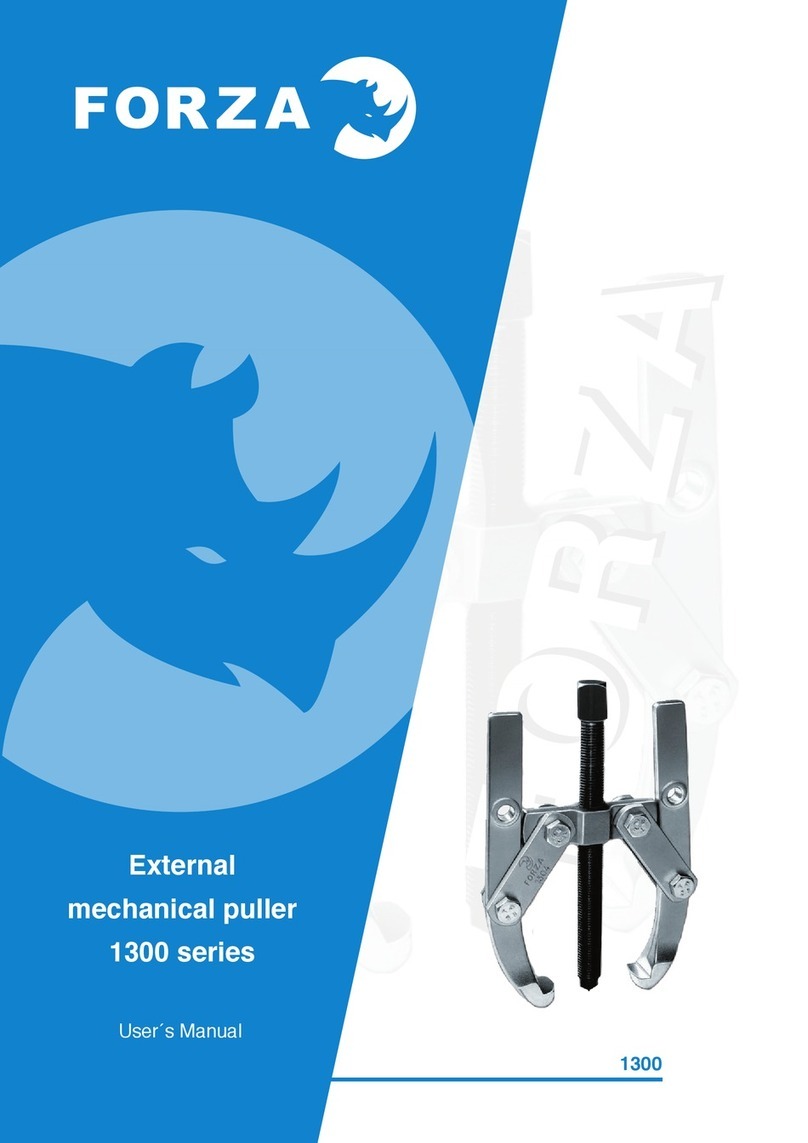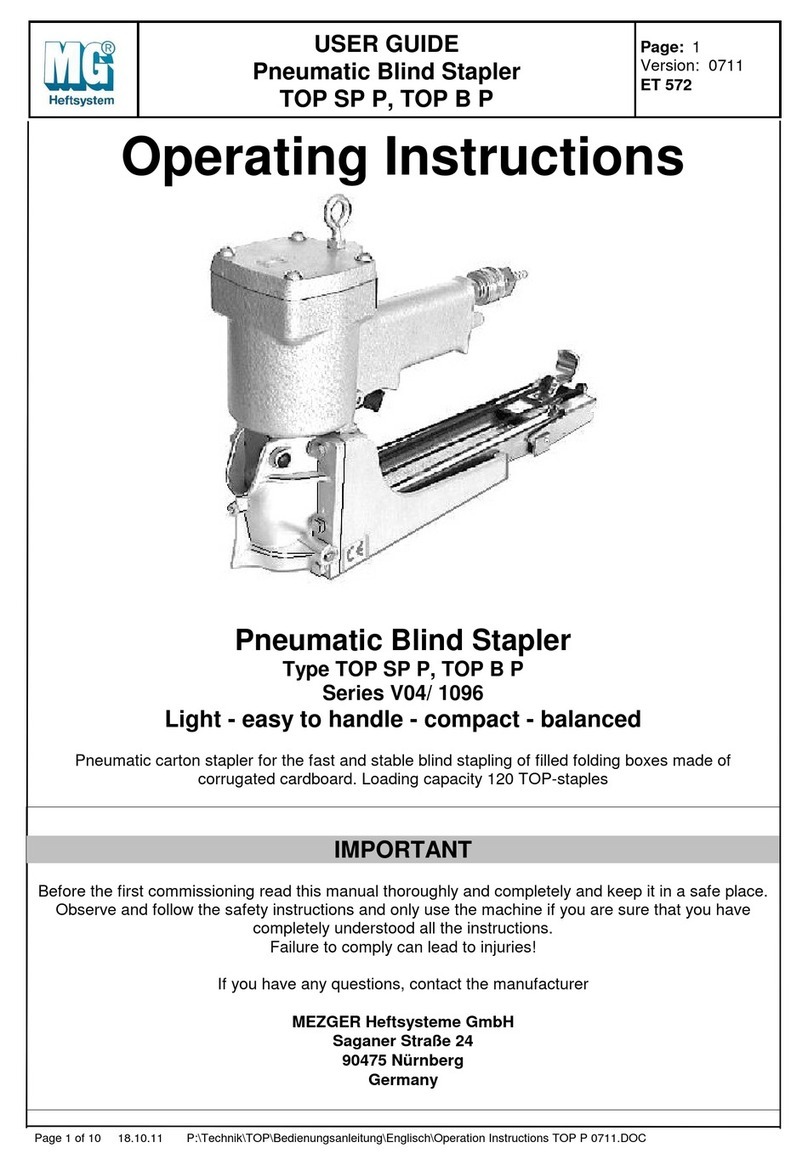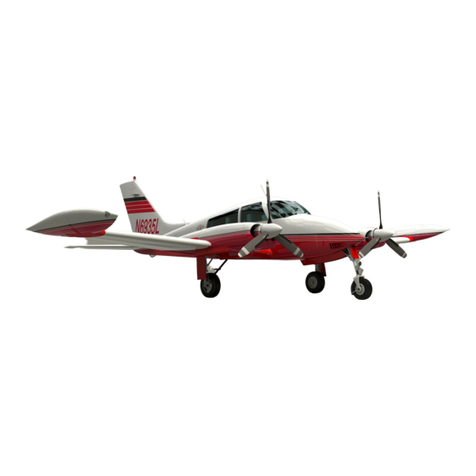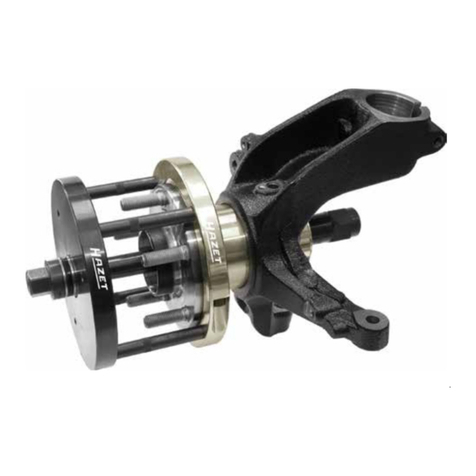Trelawny VL223EX Series User manual

ATEX Certified VL223Ex Challenger Needle Scaler
Operation and Maintenance Manual
www.trelawnyspt.co.uk



OPERATION
General Information
Before operating, performing maintenance or repairing
the ATEX Certified VL223Ex Needle Scaler, this manual
must be read and understood. If in any doubt, ask your
supervisor before using this equipment.
Local safety regulations must be followed at all times.
Failure to follow these instructions could result in damage
to the Scaler and/or personal injury.
Operators should be familiar with the data given in the
specification section. Please keep these instructions in a
safe and accessible place.
Trelawny SPT Limited disclaims all responsibility for
damage to persons or objects arising as a consequence
of incorrect handling of the tool, failure to inspect the tool
for damage or other faults that may influence the
operation prior to starting work, or failure to follow the
safety regulations listed or applicable to the job site.
The tool is primarily designed for the removal of paint,
rust and scale, it can be used both indoors and out.
This tool must not be used in a fixture.
Air Supply
The compressed air must be free from water and dirt. The
installation of a filter/regulator/lubricator air preparation
set (with moisture trap) adjacent to the tool is strongly
recommended.
In particularly cold temperatures it is recommended that a
proprietary anti-freeze lubricating oil is used.
Always clear the air hose before connection to the tool.
Ensure that no moisture (condensation) is present in the
air hose.
Ensure that only 10mm (3/8”) bore Antistatic air hose is
used and that all couplings are secure, leak free and in
good condition. (See Parts list for recommended hose.)
For maximum efficiency, limit the length of air hose to
10M (33ft). Where extra length is necessary, for each
additional 15M (50ft) of air hose used, the pressure drop
is approximately 0.16bar (3psi).
The correct air pressure for this machine is to 6.2bar
(90psi).
Do not let the operating pressure fall below 5.5bar
(80p.s.i.) or rise above 6.9bar (100 psi) absolute
maximum.
The compressor should be able to supply a minimum of
3.77 L/s (8cfm) of free air not displaced as quoted by
some compressor manufactures, this will give 3cfm of
headroom, so that the compressor isn’t continually
running.
NOTE:
If this tool stops working, it is most likely that the plastic
(17) ball has worn excessively and may have passed into
the cylinder, check the cylinder exhaust holes for the
remnant also. This is designed to run for approximately
160hrs before requiring replacement. (Spare balls are
supplied with the tool)
Safety
Always, read instructions first before use.
Do -
Be aware that this tool is not electrically insulated.
Be aware that the tool can create dust and flying debris.
Keep hands and clothing away from moving parts.
Be aware of others working around you.
Ensure that this tool is lubricated daily.
Store this tool in a secure and dry environment.
Wear Personal Protective Equipment including safety
goggles, footwear, ear defenders and gloves. In some
environments it will be necessary to wear facemasks or
breathing apparatus. (Vacuum shroud available)
Always observe safe-working practices at all times.
Do not -
Allow the tool to run unattended.
Use the Scaler as a lever.
Modify this tool in any way, this will invalidate the
warranty and could also lead to serious injury.
Use wire or any other fixing to lock the throttle lever in the
on/open position.
Operate tool with the front tube (34) removed.
Use the tool in potentially explosive environments.
Drag the tool by the air hose.
Use petrol (gasoline), thinners or any other high flash
point solvent to clean the tool.
Use the tool if you become tired, this can lead to physical
strain or injuries; where practical; use a spring balance,
balance weights or similar equipment to take the weight
of the tool.
Hold the exposed needles, whilst the tool is in use, this
could cause vibration damage to the hands.
Please note:
Unrestrained hoses can whip if they become detached.
Care must be taken to avoid damaging or tripping over
the trailing air hose.
Always use a suitable vacuum system connected to the
38mm vacuum take-off port fitted to the tool.
The Beryllium Copper spark resistant needles may create
airborne dust, which maybe harmful to health if ingested.
A Trelawny ATEX rated, 30 litre air operated vacuum
system with a HEPA filter, is available as a separate
vacuum or as a Kit containing either a VL203, VL223 or
the VL303 Needle Scaler and also comes with an Anti-
static tool air hose.
30 litre ATEX Vacuum
Part Number: 303.10KAV30/DH
30 litre ATEX Vacuum Kit with a VL203
Part Number: 139.2503
30 litre ATEX Vacuum Kit with a VL223
Part Number: 139.2523
30 litre ATEX Vacuum Kit with a VL303
Part Number: 139.2533

MAINTENANCE
Starting work
Please note,
Always use a lanyard or strap attached to a belt or
harness, but preferably this should be attached to a fixed
and secure mounting point.
Always use Trelawny Beryllium Copper Needles.
Prior to operating the tool check: -
That all fittings are secure, free from leaks and air hoses
are in good condition.
That the air pressure is correct for this tool 6.2 bar
(90 p.s.i.).
Put a few drops of a recommended lubricant into the air
inlet of the tool.
Safe use of this tool requires a solid stance and secure
foothold, the tool may be used in other postures but care
must be taken that the operator adopts a firm and stable
position.
Maintain contact with the work surface with sufficient
pressure only to keep the tool from bouncing.
Excessive pressure can prevent the tool from working to
its full capacity.
Handled correctly the VL223Ex Needle Scalers will work
quickly and efficiently.
Excessive operator pressure will not improve the tool
efficiency but could cause premature tool failure and
operator fatigue.
Never allow the tool to run continuously whilst not in
contact with the surface being prepared.
To operate the tool, pull the throttle lever (7) towards the
handle and then apply the needles to the surface to be
worked.
Do not place needles on the surface, and then pull the
throttle lever as this will result in the tool bouncing off the
surface.
To switch off, simply release the throttle lever.
Gloves and personal protective equipment must be worn
when using this tool.
Maintenance
Maintenance must only be carried out by a competent
person, in a suitably equipped workshop.
Disconnect the tool from the air supply before
carrying out any of the following operations.
Clean all debris from the exterior of the tool.
This tool has been designed so that you only require a
vice, screwdriver, 3mm pin punch and light hammer, no
other specialist tools are required to completely strip and
service the tool.
For safe efficient running and at intervals of no more than
120 hours, dismantle and clean with highly refined
paraffin.
Check all components for wear, replace the ball valve
(Item 17) and all O’Rings. Immediately after cleaning,
thoroughly oil the tool with one of the recommended
lubricants.
Removing Needles
Disconnect from air supply, hold the Cover (10a) in a vice
using the flats provided, keeping the tool vertical, unscrew
by hand, the Front Tube assembly complete with Return
Spring (32), Needles (31), and Needle Holder (30).
Check the condition of the Front Tube Locking O’Ring
(25). Take care not to invert the Needle Scaler while
removing the Front Tube (34) or the Piston (26) and
Cylinder (15) may fall out of the Intermediate Tube (22).
Remove the Needles from the Needle Holder and dispose
of the used Needles in an appropriate manner.
Re-fitting the Needles
Insert the new needles into the Needle Holder location
holes; ensure that the Needles are inserted into the
chamfered side of the holes. Fit new Front Tube Locking
O’Ring to the Intermediate Tube. Fit the Return Spring
(32) over the needles and insert the Needle assembly into
the Front Tube. Screw the Front Tube assembly onto the
intermediate Tube until hand tight.
Recommended lubricants
Oil the tool daily during use. Put a few drops of one of
the following bio-degradable air tool lubricants through
the air inlet.
SHELL Naturelle HF
CASTROL Carelube HTG 22
Always use clean oil from a sealed container and ensure
ignition temperature is above 100deg C.
Tool Dismantling
Before carrying out any dismantling, ensure the air supply
is turned off and remove the air-line from the tool. Clean
all deposits from the outside of the tool. Service kits are
available, see parts section.
Piston and Cylinder removal
Hold the Cover in a vice using the flats provided, keeping
the Front Tube (34) horizontal. Unscrewing anti-clockwise
VERY IMPORTANT
Only Trelawny Beryllium Copper Needles must be used
in this tool.
DO NOT substitute with any other needle.
IMPORTANT:
The plastic tool box containing the ATEX tool is not
ATEX certified or anti-static, neither is the foam inserts
containing the equipment.
Do not take the tool box into an ATEX restricted area.

MAINTENANCE
Vacuum Take-off
The vacuum take-off fitted is also available as a spare
part. (See parts list for take-off and cuff) which fits over
the front tube. Position the front of the cuff with the needle
tips 20mm inside, adjust as the needles wear. Tighten the
caphead screw to secure. Use a Trelawny recommended
ATEX certified vacuum, fitted with a HEPA filter for 99.9%
dust containment.
Assembly
Ensure all parts are clean and internal parts have a film of
recommended lubricant. Replace any parts that show
signs of wear. If the tool is being fully serviced, it is
strongly recommended to change all O’Rings (2), (5),
(14), (18), (25), Cushion Ring (19), Seals (13,) (29), 6mm
Ball (17) and Needle Holder (30) during assembly.
Valve assembly
Re-assembly of the VL223 is the reverse of stripping.
Secure the Cover (10a) in a vice, holding on the flats
provided, with the valve opening uppermost.
Replace the O’Ring (2) on the Valve Cap (1). Fit a new
Valve seat O’Ring (5) in the Cover with the chamfer
uppermost. Insert the Valve Stem (4), in the Valve Body
(6). Place the Valve Spring (3) on top of the Valve Stem
(4),screw down the Valve Cap (1) by hand, and then
fasten until fully tight with a flat blade screwdriver. Locate
Throttle Lever (7) in the Valve Body (6) using a 3mm
punch to align holes.
Secure by inserting Spring Pin (8).
Tool assembly
Ensure that all components are clean and lubricated with
a thin film of the recommended lubricating oil. Assembly
is the reverse of dismantling.
Secure the Cover (10) vertically in a vice using the flats
provided, insert the Cylinder Guide Plate (12) ensuring
that the flat face is uppermost, ensure that it is located
onto the shoulder at the bottom of the threaded section
inside the Cover. Fit the Cylinder’s stem into the bore of
the Cylinder Guide Plate. With the removal holes
uppermost carefully slide the Intermediate Tube over the
Cylinder, screwing down by hand. Finally tighten by using
a 6mm bar x 200mm through the holes provided. (Do not
over tighten). Gently insert the Piston (26), small
diameter first into the Intermediate Tube (22), if
resistance is felt, turn the Piston slightly until it is located
in the Cylinder.
Note: When removing tool from vice, do not point the
front of the tool downward; the piston will fall out of the
tube and become damaged. Remove the tool from the
vice and follow as per Re-fitting the Needles, hold the tool
vertical when completing this operation.
Disposal
Dismantle into component form, segregate according to
material composition and dispose of using waste
recycling processes specified by local regulations.
by hand, remove the Front Tube complete with the
Needles (31), Needle Holder (30) and Spring (32) as an
assembly.
Note: When removing tool from vice, do not point the
front of the tool downward; the Piston and Cylinder may
fall out of the Intermediate Tube causing damage.
Hold a clean lint free cloth over the open end of the
Intermediate Tube, remove from vice and tilt the Tube
downwards to remove the Piston (26) and Cylinder (15).
Secure the Cover (10a) in a vice with the Intermediate
Tube in the vertical position, using the flats provided.
Use a suitable 6mm bar through the holes provided,
unscrew the Intermediate Tube (22) anticlockwise.
Carefully remove the Intermediate Tube from the cover
and remove the Cylinder Guide Plate (12), which is fitted
in the Cover. The Cylinder Guide Plate can be pulled out
of the cover to gain access to the Guide Plate Seal (13).
Cylinder Ball Valve replacement
This is a consumable item and may require replacing
after approximately 120 -160 hours use; this is dependant
on the cleanliness of the air supply and frequency of
lubrication.
Do not replace this plastic ball with a steel version, as
it will damage the cylinder valve seat and piston valve pin.
The ATEX certification will also become invalid.
Remove the ball retaining O’Ring (18) from its groove just
inside the bore of the stem using a suitable pointed
implement. Remove the ball from the bore or if it has
worn excessively and may have passed into the cylinder,
check the cylinder exhaust holes for the remnant also.
Replace and refit new O’Ring into groove.
Piston Valve Pin replacement
Hold the piston in a vice by the stem, using a pair of
cutters remove the top of the Valve Pin (28), using a drill
& 6mm drill bit and remove the remainder from the piston.
A small socket (4mm) which just fits over the actual pin,
will stop damage occurring. Drive the valve pin in up to its
shoulder using a vice or a small hammer.
Valve Body - Valve Stem removal
Hold the Valve Body (6) in a vice using the flats provided.
Using a 3 mm diameter punch, drive the Throttle Lever
retaining Spring Pin (8) out of the Valve Body (6) and
withdraw the Throttle Lever (7). Remove the Valve Cap
with O’Ring (2), Valve Spring (3), Valve Stem (4) and the
Valve Seat O’Ring (5).
Valve Body removal
Remove the Front Tube and remove Needle Holder,
Needles and Return Spring as per instructions for Needle
replacement above. Replace the Front Tube without the
Needles etc, onto the Intermediate Tube and screw up
until hand tight. Hold the Valve Body flats securely in a
vice, with the Cover (10) uppermost. Turn the tool anti-
clockwise around the Valve Body by holding the Cover
and Front Tube, unscrew the Valve Body from the handle
until loose, remove from vice and finally unscrew by hand.

EXPLODED VIEW
EXPLODED VIEW
This tool is manufactured from material that does
not contain by mass more that 7.5% magnesium
in reference to metallic components.

ITEM No. PART No. DESCRIPTION
VL223Ex Components
1 615.3021 Valve Cap
2 809.0139 Valve Cap O’Ring
3 712.3022 Valve Spring
4 618.3022 Valve Stem
5 809.0089 Valve Seat O’Ring
7 716.1000 Safety Throttle Lever
8 813.0108 Roll Pin
10a 423.2023 VL223Ex Cover now only supplied as an assembly BSP Thread (inc 1-8 )
12 652.2003 Guide Plate
13 829.2003 Guide Plate Seal
14 809.0299 Guide Plate O’Ring
15 428.2003 Cylinder
17 816.3003 Plastic Ball 6mm diameter
18 809.0080 Ball Retaining O’Ring
19 809.2004 Piston Cushion
22 622.2031 Intermediate Tube
23 721.2003 Intermediate Tube Outer Sleeve
25 809.0299 Front Tube Locking O’Ring
26 612.2003 Piston
28 636.3003 Valve Pin
29 829.2002 Piston Ring
30 601.2030 3mm Needle Holder
31 403.1319 Needle set (1 x set Beryllium Copper (19 needles)
32 712.2003 Front Spring
33 620.2003 Front Tube Insert
33A 620.2003A Front Tube Spacer
34 622.2030 Front Tube
35 809.3005 Cylinder Stem Reaction Ring
NOT SHOWN IN EXPLODED VIEW
418.2003 Vacuum take-off (with flat cuff)
731.2103 Flat Cuff
732.2101 Corner Cuff
732.2102 Edge Cuff
720.2003 Fall Arrester
415.3003 Anti-Static Lanyard
819.2375 Connector 1/4” BSPT-3/8” Stem
843.0825 Adapter 1/4” BSP to 1/4” NPT
458.1530 1/4” BSP Oiler with whip hose and whip check
427.5330 Claw Coupling Y-Connector with snap connectors. (Comes with two 3/8” hose connectors & hose clips)
421.3530 Anti-static air hose (10mtr) 1/4” BSP/Open
446.2003X Service Kit for ATEX (VL203/223)
PARTS LIST VL223Ex

TECHNICAL SPECIFICATION
Machinery Directive Information:
This tool has been designed and produced in accordance with the following directives: 2006/42/EC Machinery Directive
and applicable harmonised standard: EN ISO 1 1148-4:2012
EN ISO 11148-4: 2010 Hand Held Non-Electric (Non-Rotary Percussive Tools)
This tool conforms with the following EC legislation: ATEX directive 94/9/EC
Based on the following harmonised standards:
EN13463-1:2009
EN13464-5:2011
Notified Body: TRaC Global Ltd.
Certificate Number: TRaCC15ATEX0029X
If your company has any problem with our products or would like to discuss the possibility of an improvement being made to them, then please do not hesitate to contact us. Your
comments are both important and appreciated.
Trelawny tools are thoroughly tested under specified conditions in accordance with applicable internationally recognised standards. When a tool is used on site the
conditions may not be the same as those used in our tests.
Trelawny Surface Preparation Technology operates a policy of continuous product development and refinement and therefore reserves the right to change technical
specifications and product designs without giving prior notice.
© Copyright 2015, Trelawny SPT Limited, CV31 1XT. UK All rights reserved. Any unauthorised use or copying of the contents or part thereof is prohibited. This applies to
trademarks, model denominations, part numbers and drawings. Use only genuine Trelawny spares.
The use of non-Trelawny spare parts will invalidate the ATEX certification and also the warranty .
VL223Ex INLINE
NEEDLE
Piston Diameter 23.5mm (0.925”)
Piston Stroke (approximate) 11mm (0.43”)
BPM 2400
Air Consumption @ 6.2bar 1.89lps (4.0cfm)
Overall Length 370mm (14.5”)
Weight 2.35kg (5.18lbs)
Needle 19 x 3mm
Beryllium Copper
Noise LwA (Power Level) 90.7 db(A)
Vibration (AEQ) Primary 2.56 m/s2 (k)
Vibration (AEQ) Secondary 2.95 m/s2 (k)
TROUBLE SHOOTING CAUSE ACTION
Poor performance or lack of
power.
Low air pressure. Ensure that the air pressure is correct at 90psi, max 100psi.
If tool has been left for some time without use, the oil
may dry out slightly, causing a sticky residue.
Strip tool down, clean and re-oil.
Needles worn or some missing. Replace with new set of BC needles and needle holder.
Piston seal worn. Remove seal from piston and fit into bore of cylinder. If it
drops to the bottom of the bore, a replacement is required.
Valve pin worn. Replace valve pin and 6mm plastic ball.
Tool continues to run with
trigger released.
Valve seal may have become dislodged through the tool
being disconnected with the trigger in the open position.
Ensure that the trigger has not been taped or wired in the
open position, reposition or replace valve seat o'ring.
High vibration. High air pressure. Ensure that the air pressure is correct at 90psi, max 100psi.
Lack of lubrication. Lubricate with the recommended air tool oil daily.
Low air pressure 70-80psi can also cause high vibration. Ensure that the air pressure is correct at 90psi, max 100psi.
Front return spring weak or broken. Replace return spring.
Guide plate seal worn. Replace guide plate seal.
Piston cushion failed. (This is a split o’ring) Replace with a new piston cushion.
6mm plastic ball worn out. Check for and remove the remains of the ball, possibly in
an exhaust hole of cylinder and renew 6mm plastic ball.
Valve pin worn. Replace valve pin and 6mm plastic ball.
Tool stopped working.
Noise Levels Noise level measured in accordance with: EN ISO 15744: 2008
Vibration Levels Vibration measured in accordance with: EN ISO 28927-9:2012 and
EN ISO 20643:2005. (k) Equals the factor of uncertainty, which allows for variations
in measurement and production. Vibration Data figures are tri-axial, which gives the
total vibration emission. Because of various factors, the range of vibration from these
tools may vary between -0% +40%. The vibration is dependent on the task, the
operators grip and feed force employed etc.
NOTE: The above vibration levels were obtained from tri-axial measurements to
comply with the requirements of “The Control of Vibration at Work Regulations
2005*” and the revisions to the (8662) now EN ISO 28927-9:2012 and EN ISO
20643:2005 series of standards. These values are at least 1.4 times larger than the
values obtained from single axis measurements.
*Based on European Union Council Directive 2002/44/EC (Physical Agents
(Vibration) Directive)).
Risk of Hand Arm Injury
Because of various factors, the vibration from this range of tools may be between
2.95 m/s2 – 4.13m/s2
The vibration is dependent on the task, the operators grip, and feed force employed.

NOTES

NOTES

Trelawny SPT Ltd
13 Highdown Road, Sydenham Industrial Estate, Leamington Spa,
Warwickshire, CV31 1XT, United Kingdom
Telephone: +44 (0)1926 883781 - Fax: +44 (0)1926 450352
Email: sales@trelawny.co.uk
© TSPT UK 2015 Part No: 735.3004X issue 1 www.trelawnyspt.co.uk
This manual suits for next models
3
Table of contents
Other Trelawny Tools manuals
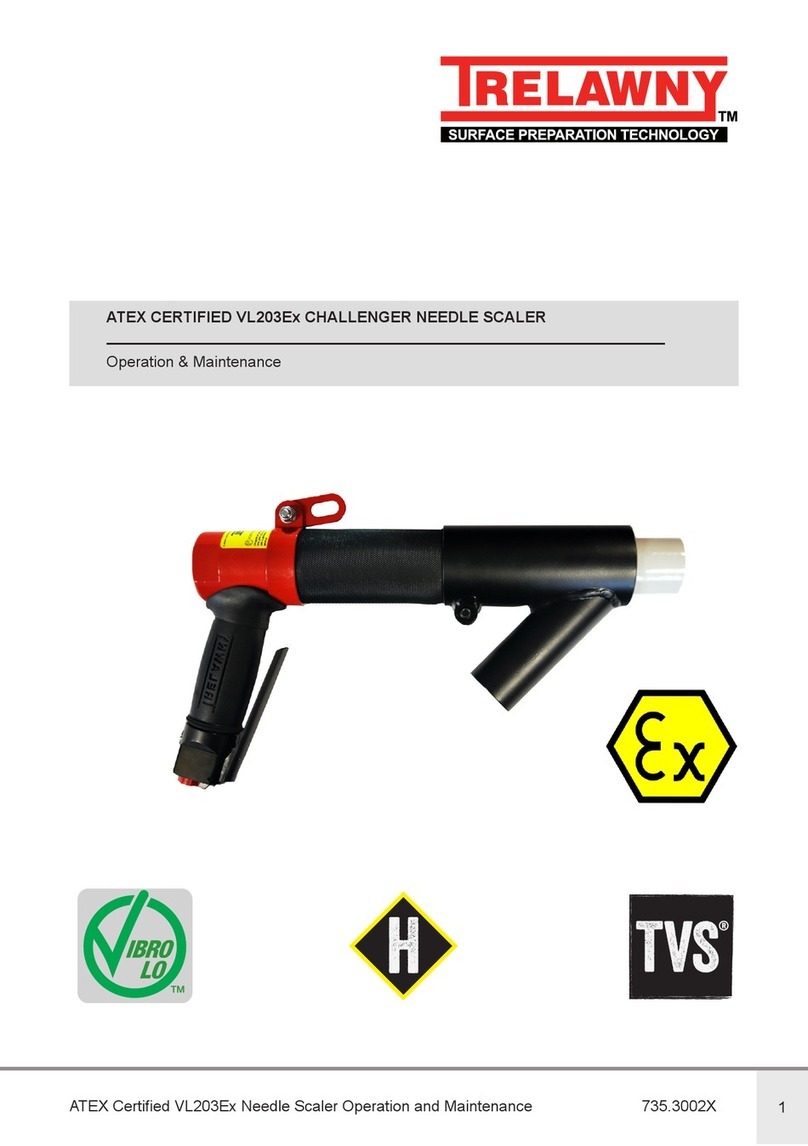
Trelawny
Trelawny VL203Ex Troubleshooting guide
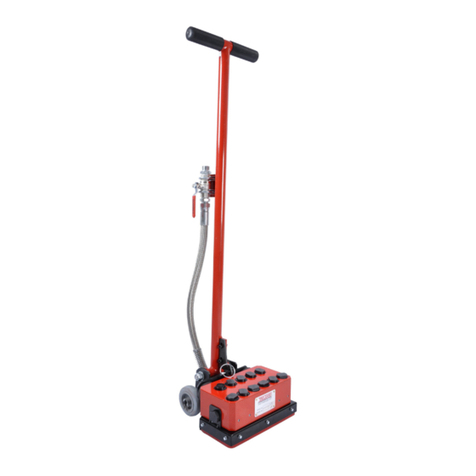
Trelawny
Trelawny SF11EX User manual
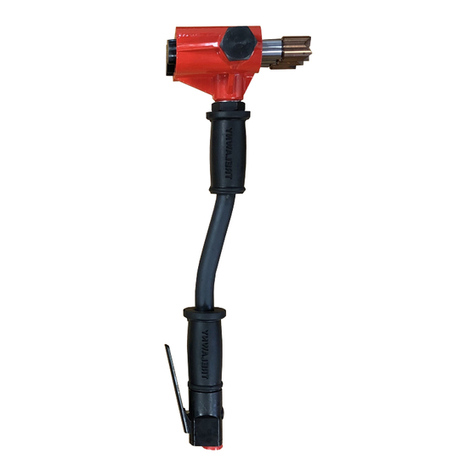
Trelawny
Trelawny SF3EX User manual
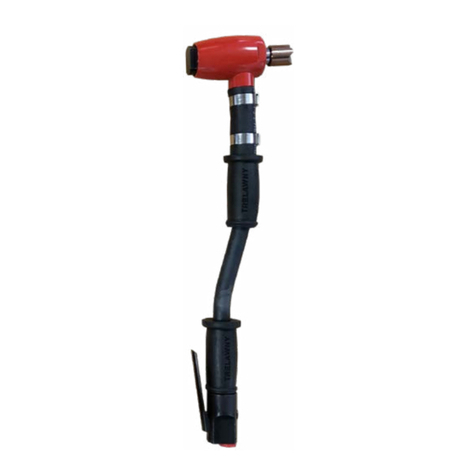
Trelawny
Trelawny VLSF1EX User manual

Trelawny
Trelawny Single Scaler Standard Duty User manual

Trelawny
Trelawny LPS55 User manual

Trelawny
Trelawny Vibro Lo Troubleshooting guide

Trelawny
Trelawny Trident Neptune User manual
